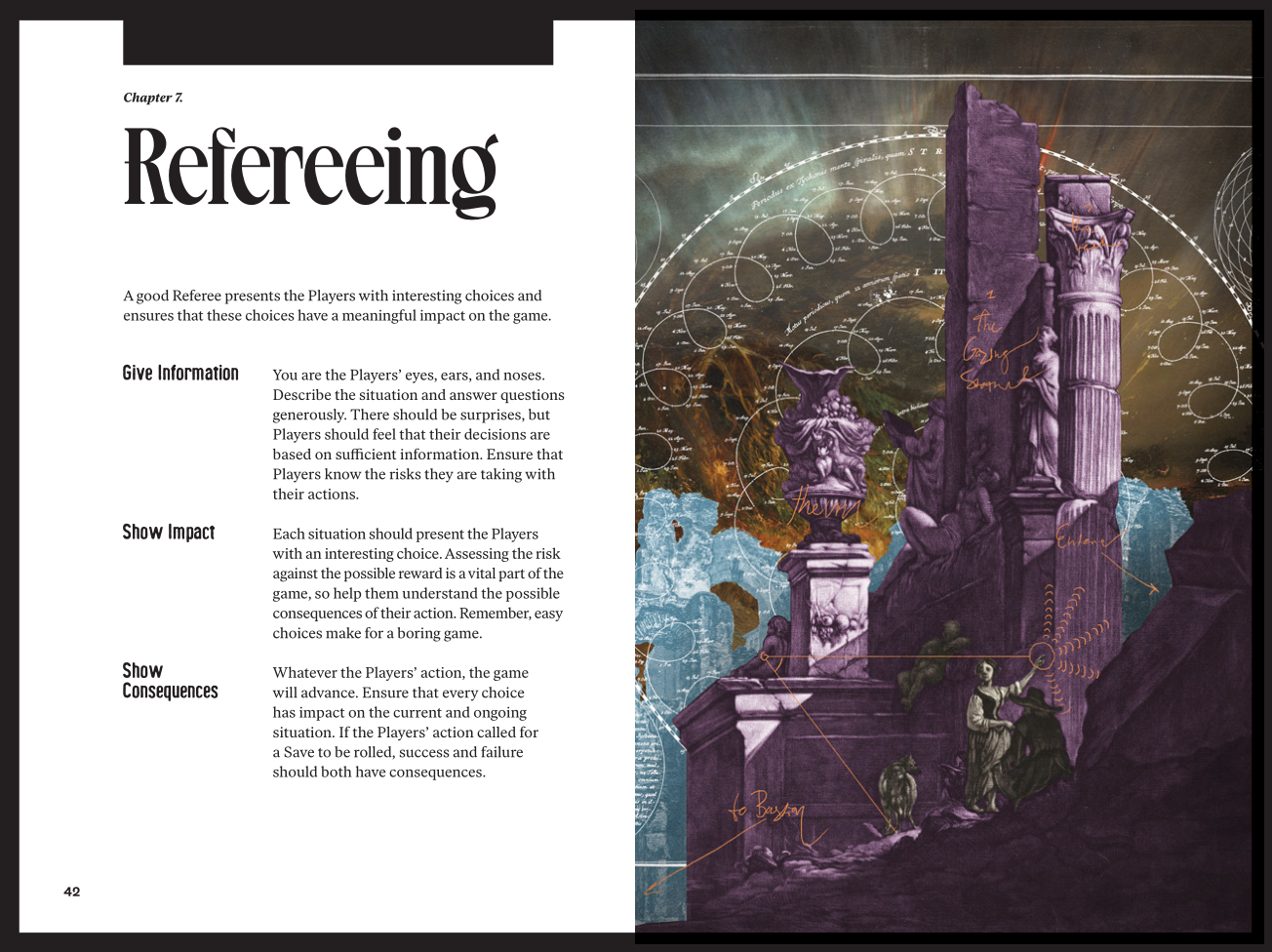Into The Odd
Look at this book, it has these stupendous art house collage
on its cover and strewn across the interior. It looks like a coffee table book
or something you’d find in the back room of Ye Old Rare books shoppe. I wanted
this book, it got it and now I am disappointed. A microcosm of our consumer
society right there.
In to the Odd contains three things; a rule set, an
adventure and some setting material. Two of these things are ok, but perhaps
slightly miss the target, one is awful.
The rules system: There has been a trend in modern indie
RPGs to take the husk of 70s D&D and strip it down to the essentials. The
70s game was many things, it was a resource management game, it was a maze
exploration game, it was a combat game, it was a push your luck game and it was
an improv encounter solution game. In to the Odd says this last element, the
encounter shenanigans, is the game.
The actual game rules are a few paragraphs on two pages.
Each character has 3 stats; Strength, Dexterity and Will. When the player wants
to do something or when something bad might happen to them, they roll under
their ‘save’ value and get a result they want. That’s it. Combat is just
rolling damage (not attack roles) and there is some information tracking etc
but not much. It leans in on the free Kriegspeil heritage of RPGs and falls
right in.
For me 70s D&D is probably the goldilocks zone for rules
and systems weight. I appreciate that lighter games may favour some and it is a
matter of taste. There is nothing intrinsically bad about this rule set, it’s
not very evocative but it will work and it makes combat inherently dangerous as
damage is always dealt. However it gives the players and the GM no hints as to
how play will proceed of itself. A game with resource tracking, e.g. light or
food, or a game with a stealth system tells the players something about what
they are intended to be doing and what the challenges are. Into the Odd does not
have this direction.
It does have equipment. The setting of Into the Odd is like
A Roadside Picnic in post-apocalyptic late Georgian England. It’s a great
concept and the equipment is the main vector for this concept and potentially
where the game is. When a player character is created there is a chance they
will get an ‘Arcana’, read magic item. And the main object of the players is to
get more of these objects. There is a d66 table of example Arcana given, and
these are generally great. If the game is about encounters and creative problem
solving then the better Arcana are the thing that allow lateral thinking from
the players. There is the portal gun, from Valves portal games under a
different name, there’s a ray gun that causes an individual to repeat their
last action as if in a time loop, a coin that drives thieves mad with envy.
These are evocative and an easy route to a few interesting encounters. I do
wonder whether having one interesting ability will wear thin fast however.
Ok, so rules that focus on encounters that are functional,
and a good magic items list, but what about example encounters. This is where
the book nose plants. About 40 pages of the book is an introductory adventure.
It includes one large multi-level dungeon, a hex crawl and several small
dungeons, and it sucks. Each room is 1-3 bullet points and most of them are
either statements of the obvious or dull. There is a white chair in this room,
or machinery fragments, or a corpse on the floor. It is largely banal with the
occasional good idea such as a glass gas chamber that has no context or
meaning. There are wandering monsters, a classic D&D system, and they are
wacky but what they are doing and why is left entirely to the referee. If
wandering around some rooms and periodically bumping into a glass killer insect
sounds like good adventure design to you then get this.
The real shame here is that it is the example of how to play
this game. If I compare this to the example adventure on Dungeon Crawl Classics
it’s a non-contest. The two games have a similar idea, the weird encounter and
lateral thinking is the game. Dungeon Crawl Classics nails this with
interactive encounters that stick in the referees and players minds. This is
just a string of weird monsters.
Lastly the setting. The City of Bastion is described in two
paragraphs, I’ve not counted but I’d guess under 100 words, the surrounding countryside
gets another two, then the wildernesses beyond another two. The actual setting
description is so light it perhaps should have been reduced to a single line.
Better is the implied setting sprinkled though out the book or the final
chapter, the Oddpedium. This final chapter might be the best bit of the book,
it’s a series of random tables which is usually the hunting ground of indie
RPGs. It has evocative generators for ‘What’s that Island?’ or ‘Astral Cults’ or
the latest policy of the city council. There are some good ideas here and it
evokes the 1930s pulp fantasy literature such as the Moonpool or lost world
narratives.
I’m not really sure who Into the Odd is for, perhaps just
hipsters. For people new to RPGs I think it is too esoteric and actually to
light. RPGS occur in the minds of the players and you need to broadly have a
share conception of what is going on. With rules so light and such a woolly and
off beat setting I can see constructing this share thought space to be quite
difficult. A game like Mothership does this much better. Its rules are simple
but intuitive, you roll skills to do things. The setting is broad dirty Sci-Fi
something most people who would consider and RPG are familiar with. It has an
easy buy in. I don’t know how I would sell into the Odd to my friends. Whilst
it is thin the main attraction to me is some of the weird sci-fi fantasy
elements it taps into, the Roadside Picnic, the lost world stories. To the eBay
pile.



Comments
Post a Comment